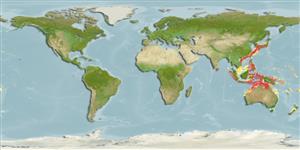Actinopterygii (ray-finned fishes) >
Tetraodontiformes (Puffers and filefishes) >
Tetraodontidae (Puffers) > Tetraodontinae
Etymology: Lagocephalus: Greek, lagos = hare + Greek, kephale = head (Ref. 45335).
Environment / Climate / Range
Ecology
Marine; demersal. Tropical, preferred ?
Indo-West Pacific: Shizuoka Prefecture, Japan to the West Pacific.
Size / Weight / Age
Maturity: Lm ? range ? - ? cm
Max length : 35.0 cm SL male/unsexed; (Ref. 559)
Dorsal
spines
(total): 0;
Dorsal
soft rays
(total): 13;
Anal
spines: 0;
Anal
soft rays: 12. Body covered with prickles. Caudal fin double emarginate, middle of fin convex. Blackish-brown dorsally, silver ventrally. Pectoral and dorsal fins dark; anal fin white; caudal fin black with upper and lower white tips (Ref. 559).
Life cycle and mating behavior
Maturity | Reproduction | Spawning | Eggs | Fecundity | Larvae
Masuda, H., K. Amaoka, C. Araga, T. Uyeno and T. Yoshino, 1984. The fishes of the Japanese Archipelago. Vol. 1. Tokai University Press, Tokyo, Japan. 437 p. (text). (Ref. 559)
IUCN Red List Status (Ref. 115185)
CITES (Ref. 94142)
Not Evaluated
Threat to humans
Poisonous to eat (Ref. 9137)
Human uses
More information
ReferencesAquacultureAquaculture profileStrainsGeneticsAllele frequenciesHeritabilityDiseasesProcessingMass conversion
Tools
Special reports
Download XML
Internet sources
Estimates of some properties based on models
Phylogenetic diversity index (Ref.
82805): PD
50 = 0.5005 [Uniqueness, from 0.5 = low to 2.0 = high].
Bayesian length-weight: a=0.01995 (0.00839 - 0.04746), b=2.88 (2.70 - 3.06), in cm Total Length, based on LWR estimates for this Genus-body shape (Ref.
93245).
Trophic Level (Ref.
69278): 3.7 ±0.4 se; Based on size and trophs of closest relatives
Resilience (Ref.
69278): Medium, minimum population doubling time 1.4 - 4.4 years (Preliminary K or Fecundity.).
Vulnerability (Ref.
59153): Moderate vulnerability (36 of 100) .
